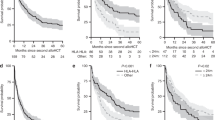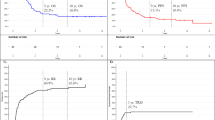Summary:
The outcome of patients with multiple myeloma treated with standard therapy is disappointing, with a historical median survival of 3 years. Although high-dose therapy with autologous stem cell transplant has improved treatment outcomes, cure is unlikely. Allogeneic transplant provides a tumor-free graft and a graft-versus-myeloma effect. However, only a minority of patients has a compatible sibling donor. Unrelated hematopoietic stem cell transplant is another option. We analyzed the outcome of patients who received an unrelated bone marrow transplant facilitated by the National Marrow Donor Program (NMDP). Between 1989 and 2000, 71 patients received a myeloablative unrelated transplant for multiple myeloma; 70 patients consented for this analysis. The median recipient age was 44 years. A total of 31% of patients had received a prior autologous transplant. In all, 91% of patients engrafted. The 3-year cumulative incidence estimate of relapse was 34±10%. The incidence of Grade II–IV GVHD was 47%. The Kaplan–Meier estimate for overall survival at 5 years was 9±7%. The 100-day treatment-related mortality was 42%. In multivariate analysis, only a male donor was a significant predictor for survival. Better strategies are needed to treat patients with multiple myeloma, perhaps by using less-toxic, nonmyeloablative conditioning regimens.
This is a preview of subscription content, access via your institution
Access options
Subscribe to this journal
Receive 12 print issues and online access
$259.00 per year
only $21.58 per issue
Buy this article
- Purchase on Springer Link
- Instant access to full article PDF
Prices may be subject to local taxes which are calculated during checkout


Similar content being viewed by others
References
Weber D, Dimopoulos M, Gavino M et al. Thalidomide alone or with dexamethasone for previously untreated multiple myeloma. J Clin Oncol 2003; 21: 16–19.
Alexanian R, Dimopoulos M, Delasalle K et al. Primary dexamethasone treatment of multiple myeloma. Blood 1992; 80: 887–890.
Blade J, San Miguel JF, Fontanillas M et al. Survival of multiple myeloma patients who are potential candidates for early high-dose therapy intensification/autotransplantation and who were conventionally treated. J Clin Oncol 1996; 14: 2167–2173.
Gregory WM, Richards MA, Malpas JS . Combination chemotherapy versus melphalan and prednisolone in the treatment of multiple myeloma: an overview of published trials. J Clin Oncol 1992; 10: 334–342.
Myeloma Trialists Collaborative Group. Combination chemotherapy versus melphalan and prednisone as treatment for multiple myeloma: an overview of 6633 patients from 27 randomized trials. J Clin Oncol 1998; 16: 3832–3842.
Osterborg A, Ahre A, Bjorkholm M et al. Alternating combination chemotherapy (VMCP/VBAP) is not superior to melphalan/prednisone in the treatment of multiple myeloma patients Stage III – a randomized study from MGCS. Eur J Hematol 1989; 43: 54–62.
Attal M, Harousseau JL, Stoppa AM et al. A prospective randomized trial of autologous bone marrow transplantation and chemotherapy in multiple myeloma. N Engl J Med 1996; 335: 91–97.
Child JA, Morgan GJ, Davies Fe et al. High dose chemotherapy with hematopoietic stem-cell rescue for multiple myeloma. N Engl J Med 2003; 348: 1875–1883.
Lennoff S, Hjorth M, Holmberg E et al. Impact on survival of high-dose therapy with autologous stem cell support in patients younger than 60 years with newly diagnosed multiple myeloma: a population based study. Blood 2000; 95: 7–11.
Fermand JP, Ravaud P, Chevret S et al. High-dose therapy and autologous peripheral blood stem cell transplantation in multiple myeloma: up-front or rescue treatment? Results of a multicenter sequential randomized clinical trial. Blood 1998; 92: 3131–3136.
Vesole DH, Tricot G, Jagannath S et al. Autotransplants in multiple myeloma: what have we learned? Blood 1996; 88: 838–847.
Fermand JP, Chevret S, Ravaud P et al. High-dose chemoradiotherapy and autologous blood stem cell transplantation in multiple myeloma: results of a Phase II trial involving 63 patients. Blood 1998; 82: 2005–2009.
Fassas A, Barlogie B, Ward S et al. Survival after relapse following tandem autotransplants in multiple myeloma patients: the University of Arkansas total therapy I experience. Brit J Hematol 2003; 123: 484–489.
Palumbo A, Bringhen S, Bertola A et al. Multiple myeloma: comparison of two dose-intensive melphalan regimens (100 vs 200 mg/m2). Leukemia 2004; 18: 133–138.
Desikan R, Barlogie B, Sawyer J et al. Results of high-dose therapy for 1000 patients with multiple myeloma: durable complete remission and superior survival in the absence of chromosome 13 abnormalities. Blood 2000; 95: 4008–4010.
Attal M, Harousseau JL, Facon T et al. Single versus double autologous stem cell transplant for multiple myeloma. N Engl J Med 2003; 349: 2495–2502.
Mehta J, Singhal S . Graft versus myeloma. Bone Marrow Transplant 1998; 11: 835–843.
Majolini I, Corradini P, Scime R et al. High rate of remission and low rate of disease recurrence in patients with multiple myeloma allografted with PBSC from their HLA-identical sibling donors. Bone Marrow Transplant 2003; 31: 767–773.
Gahrton G, Tura S, Ljungman P et al. Prognostic factors in allogeneic bone marrow transplantation for multiple myeloma. J Clin Oncol 1995; 13: 1312–1322.
Alyea E, Weller E, Schlossman R et al. Outcome after autologous and allogeneic stem cell transplantation for patients with multiple myeloma: impact of graft-versus-myeloma effect. Bone Marrrow Transplant 2003; 32: 1145–1151.
Bensinger WI, Buckner CD, Anasetti C et al. Allogeneic marrow transplantation for multiple myeloma: an analysis of risk factors on outcome. Blood 1996; 88: 2787–2793.
Lee CK, Badros A, Barlogie B et al. Prognostic factors in allogeneic transplantation for patients with high-risk multiple myeloma after reduced intensity conditioning. Exp Hematol 2003; 31: 73–80.
Giralt S, Aleman A, Anagnostopoulos A et al. Fludarabine/melphalan conditioning for allogenenic transplantation in patients with multiple myeloma. Bone Marrow Transplant 2002; 30: 367–373.
Anasetti C, Beatty PG, Storb R et al. Effect of HLA incompatibility on graft-versus-host disease, relapse, and survival after marrow transplantation for patients with leukemia or lymphoma. Hum Immunol 1990; 29: 79–81.
National Marrow Donor Program Statistics 2002. www.marrow.org
Hansen JA, Gooley TA, Martin PJ et al. Bone marrow transplants from unrelated donors for patients with chronic myeloid leukemia. N Engl J Med 1998; 338: 962–968.
Kaplan EL, Meier P . Nonparametric estimation from incomplete observations. J Am Stat Assoc 1958; 53: 457–481.
Mantel M . Evaluation of survival data and two new rank order statistics arising in its consideration. Cancer Chemother Rep 1966; 50: 163–170.
Gooley TA, Leisenring W, Crowley J, Storer BE . Estimation of failure probabilities in the presence of competing risks: new representations of old estimators. Stat Med 1999; 18: 695–706.
Blade J, Samson D, Reece D et al. Criteria for evaluating disease response and progression in patients with multiple myeloma treated by high dose therapy and hematopoietic stem cell transplantation. Br J Hematol 1998; 102: 1115–1123.
Cox DR . Regression models and life tables. JR Stat Soc B 1972; 34: 187–200.
Drobyski WR, Pelz C, Kahler-Babbitt C et al. Successful unrelated marrow transplantation for patients over the age of 40 with chronic myelogenous leukemia. Biol Blood Marrow Transplant 1998; 4: 3–12.
Bjorkstrand B, Ljungman P, Svensson H et al. Allogeneic bone marrow transplantation versus autologous stem cell transplantation in multiple myeloma: a retrospective case-matched study from the European Group for Blood and Marrow Transplantation. Blood 1996; 88: 4711–4718.
LeBlanc R, Montminy-Metivier S, Belanger R et al. Allogeneic transplantation for multiple myeloma: further evidence for a GVHD-associated graft-versus-myeloma effect. Bone Marrow Transplant 2001; 28: 841–848.
Orsini E, Alyea EP, Chillemi A et al. Conversion to full donor chimerism following donor lymphocyte infusion is associated with disease response in patients with multiple myeloma. Biol Blood Marrow Transplant 2000; 6: 375–376.
Perez-Simon JA, Martino R, Alegre A et al. Chronic but not acute graft-versus-host disease improves outcome in multiple myeloma patients after non-myeloablative allogeneic transplantation. Br J Hematol 2003; 121: 104–108.
Tricot G, Spencer T, Sawyer J et al. Predicting long-term (>5 years) event-free survival in multiple myeloma patients following planned tandem autotransplants. Br J Hematol 2002; 116: 211–217.
Kulkarni S, Powles RL, Treleaven JG et al. Impact of previous high-dose therapy on outcomes after allografting for multiple myeloma. Bone Marrow Transplant 2000; 23: 675–680.
Kernan NA, Bartsch G, Ash RC . Analysis of 462 transplantations from unrelated donor facilitated by the National Marrow Donor Program. N Engl J Med 1993; 328: 593–602.
Giralt S, Estey E, Albitar M et al. Engraftment of allogeneic hematopoietic progenitor cells with purine analog-containing chemotherapy: harnessing graft-versus-leukemia without myeloablative therapy. Blood 1997; 89: 4531–4536.
Slavin S, Nagler A, Naprstek E et al. Nonmyeloablative stem cell transplantation and cell therapy as an alternative to conventional bone marrow transplantation with lethal cytoreduction for the treatment of malignant and nonmalignant hematologic diseases. Blood 1998; 91: 756–763.
Khouri IS, Keating M, Korbling M et al. Transplant-lite: induction of graft-versus-malignancy using fludarabine-based nonablative chemotherapy and allogeneic blood progenitor-cell transplantation as treatment for lymphoid malignancies. J Clin Oncol 1998; 16: 2817–2824.
Badros A, Barlogie B, Morris C et al. Improved outcome of allogeneic transplantation in high-risk multiple myeloma patients after nonmyeloablative conditioning. J Clin Oncol 2002; 20: 1295–1303.
Giralt S, Aleman A, Anagnostopoulos A et al. Fludarabine/melphalan conditioning for allogeneic transplantation in patients with multiple myeloma. Bone Marrow Transplant 2002; 30: 367–373.
Kroger N, Sayer HG, Schwerdtfeger R et al. Unrelated stem cell transplantation in multiple myeloma after a reduced-intensity conditioning with pretransplantation antithymocyte globulin is highly effective with low transplantation-related mortality. Blood 2002; 100: 3919–3924.
Shaw BE, Peggs K, Bird JM et al. The outcome of unrelated donor stem cell transplantation for patients with multiple myeloma. Br J Hematol 2003; 123: 886–895.
Maloney DG, Molina AJ, Sahebi F et al. Allografting with nonmyeloablative conditioning following cytoreductive autografts for the treatment of patients with multiple myeloma. Blood 2003; 102: 3447–3454.
Kroger N, Schwerdtfeger R, Kiehl M et al. Autologous stem cell transplantation followed by a dose-reduced allograft induces high complete remission rate in multiple myeloma. Blood 2002; 100: 755–760.
Acknowledgements
This research has been supported by funding from the National Marrow Donor Program, the Health Resources Services Administration #240-97-0036 to the National Marrow Donor Program. The views expressed in this article do not reflect the official policy or position of the US government.
Author information
Authors and Affiliations
Corresponding author
Rights and permissions
About this article
Cite this article
Ballen, K., King, R., Carston, M. et al. Outcome of unrelated transplants in patients with multiple myeloma. Bone Marrow Transplant 35, 675–681 (2005). https://doi.org/10.1038/sj.bmt.1704868
Received:
Accepted:
Published:
Issue Date:
DOI: https://doi.org/10.1038/sj.bmt.1704868
Keywords
This article is cited by
-
Role of allogeneic stem cell transplantation in multiple myeloma
Current Hematologic Malignancy Reports (2008)
-
Serological identification and bioinformatics analysis of immunogenic antigens in multiple myeloma
Cancer Immunology, Immunotherapy (2006)



